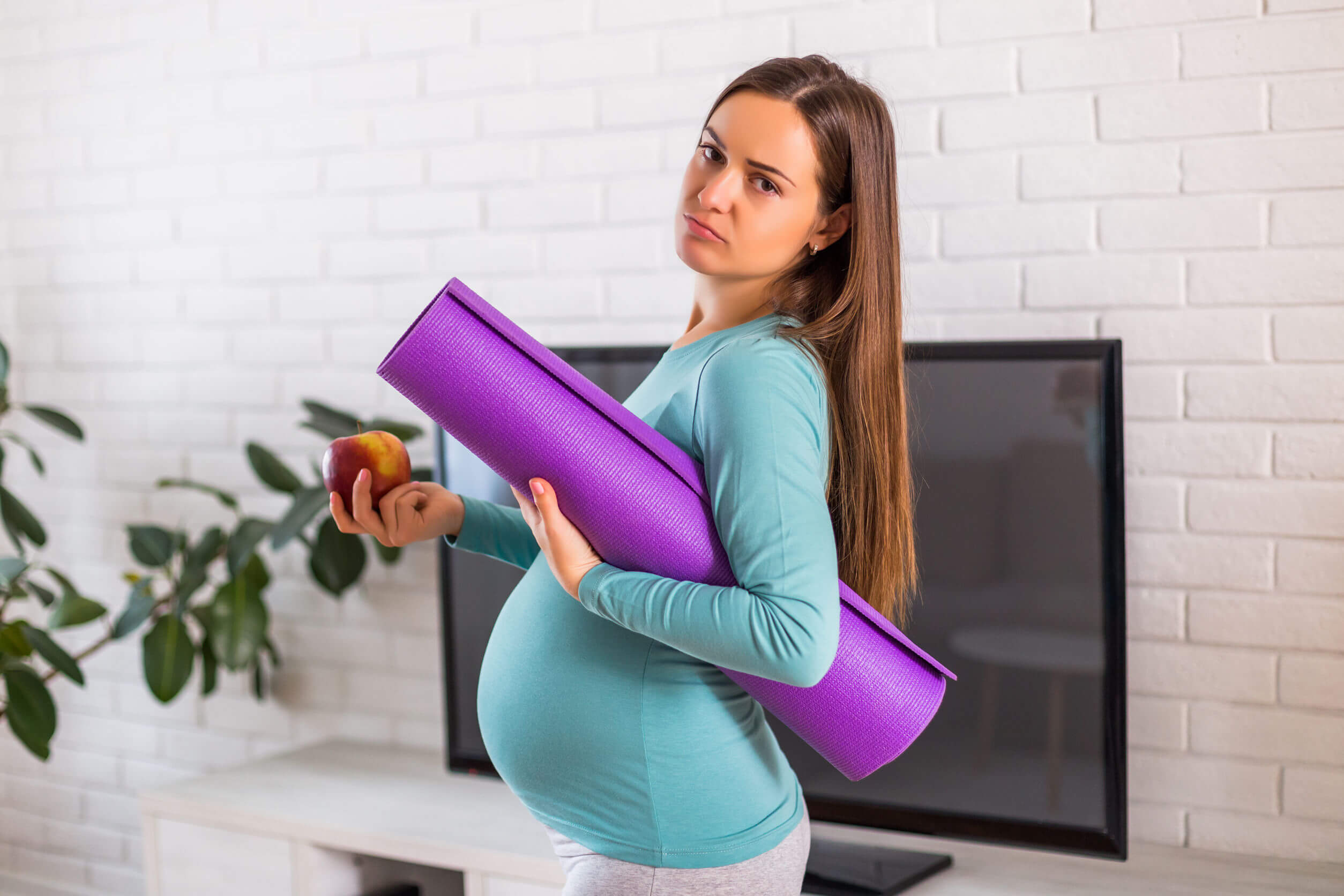Childbirth Preparation Exercises


Written and verified by the doctor Diego Pereira
Childbirth preparation exercises are very common among new mothers, as they help to avoid or reduce many of the uncomfortable symptoms during childbirth. That’s why we’ve prepared the following article so that you can learn how to detect the muscles involved in childbirth and how to train them correctly.
Kegel exercises and perineal massage can be done at home, but they must be complemented with proper breathing and relaxation techniques. If you have trouble staying calm or suffer from anxiety, you may need to attend childbirth preparation classes.
Why are childbirth preparation exercises important?

Childbirth preparation exercises are vital to ensure proper management of the situation, although there’s no definitive proof that they help reduce complications during the birth of the baby.
Whether or not you’re a first-timer, most of us know the characteristics of childbirth. The passage of the future baby through the vagina not only causes pain but also stimulates some parts of your body that may not be prepared for such an event, especially if you’re young.
These exercises prepare you from an emotional and physical point of view for childbirth. The mental part aspect is very important, as strength in this area is what will allow you to align your breathing, thoughts, and body for a single purpose.
Physical preparation is also very important. The perineum, which occupies much of the floor of the pelvis, is made up of many muscles and other tissues that, if stretched more than possible, can be injured. While your body “should” be ready after nine months of pregnancy, it never hurts to prepare!
Find out more: 5 Exercise Apps to Stay in Shape During Pregnancy
2 types of birth preparation exercises
Next, we’ll talk about Kegel exercises and perineum massage. They may seem more or less similar at first, but they’re intended to train different structures. It’s best to start them about 6-8 weeks before your due date.
Kegel exercises
The main purpose of Kegel exercises is to strengthen the pubococcygeus muscle, which is closely related to sphincter activity, especially anal. You’re probably wondering what these structures are.
Sphincters are sets of muscle fibers, whose origin can come from various regions, that are capable of opening and closing to allow the passage of substances between two cavities or even between the body and the exterior. The urinary and anal sphincters are examples of the latter group.
These exercises were created in the middle of the 20th century to improve the symptoms of anal and urinary incontinence, especially in women after childbirth. Gradually, their use became widespread, being applicable to patients with different diseases suffering from the same condition as in men operated on for prostate disease.
How to perform Kegel exercises?
The most important thing is to know how to locate the muscles involved. To do this, you can try going to the bathroom and holding the flow of urine; it won’t take you long to recognize the specific area. According to this review article (2018) it may be necessary to insert a finger into the vagina to learn how to contract the necessary muscles.
So, follow these steps to train your musculature in the best possible way:
- Sit in a chair, with your back well supported and your feet apart (touching the floor).
- Breathe deeply and regularly for a few seconds, until you feel comfortable.
- Contract your pelvic muscles as best you can; you’ll feel them pull up a little.
- Once you reach the maximum point, hold this position for 5 seconds.
- Slowly relax the muscles over a period of about 10 seconds.
- Repeat this session about 10 times in the same position 3 times a day.
Although that’s the position we recommend, you can actually do it in a variety of ways, such as lying down or on your side. It depends on your comfort, dexterity, and particular tastes, as the important thing is to exercise.
Find out more: Perineal Massage: How to Perform It
Perineum massage

Perineum massage is nothing more than a simple massage in the area to promote relaxation and preparation. There are several techniques, but one of the most recommended is to use a little natural oil and your hands (clean) to make synchronous and gentle movements in the perineum.
They can be performed in the position you prefer and the movements can be circular or follow the path of the muscles in the area. An important part of the massage is to slightly introduce the fingers into the vagina and gently press downward, slightly resembling the movement that the baby will make during childbirth.
For this last step, it’s advisable to clean your hands and use only a little water. Some oils can cause allergic reactions or irritation, and we don’t want these massages to become uncomfortable.
If in doubt, consult your doctor
Although these childbirth preparation exercises are very generic and therefore applicable to all women, there are some health conditions that may require additional methods to prepare you.
In some cases, there may be a condition called fetal-pelvic disproportion, in which the size of the baby is inadequate for your pelvis, so a cesarean section would be recommended. A correct prenatal checkup will allow you to know these and other details with certainty and some time in advance.
Childbirth preparation exercises are very common among new mothers, as they help to avoid or reduce many of the uncomfortable symptoms during childbirth. That’s why we’ve prepared the following article so that you can learn how to detect the muscles involved in childbirth and how to train them correctly.
Kegel exercises and perineal massage can be done at home, but they must be complemented with proper breathing and relaxation techniques. If you have trouble staying calm or suffer from anxiety, you may need to attend childbirth preparation classes.
Why are childbirth preparation exercises important?

Childbirth preparation exercises are vital to ensure proper management of the situation, although there’s no definitive proof that they help reduce complications during the birth of the baby.
Whether or not you’re a first-timer, most of us know the characteristics of childbirth. The passage of the future baby through the vagina not only causes pain but also stimulates some parts of your body that may not be prepared for such an event, especially if you’re young.
These exercises prepare you from an emotional and physical point of view for childbirth. The mental part aspect is very important, as strength in this area is what will allow you to align your breathing, thoughts, and body for a single purpose.
Physical preparation is also very important. The perineum, which occupies much of the floor of the pelvis, is made up of many muscles and other tissues that, if stretched more than possible, can be injured. While your body “should” be ready after nine months of pregnancy, it never hurts to prepare!
Find out more: 5 Exercise Apps to Stay in Shape During Pregnancy
2 types of birth preparation exercises
Next, we’ll talk about Kegel exercises and perineum massage. They may seem more or less similar at first, but they’re intended to train different structures. It’s best to start them about 6-8 weeks before your due date.
Kegel exercises
The main purpose of Kegel exercises is to strengthen the pubococcygeus muscle, which is closely related to sphincter activity, especially anal. You’re probably wondering what these structures are.
Sphincters are sets of muscle fibers, whose origin can come from various regions, that are capable of opening and closing to allow the passage of substances between two cavities or even between the body and the exterior. The urinary and anal sphincters are examples of the latter group.
These exercises were created in the middle of the 20th century to improve the symptoms of anal and urinary incontinence, especially in women after childbirth. Gradually, their use became widespread, being applicable to patients with different diseases suffering from the same condition as in men operated on for prostate disease.
How to perform Kegel exercises?
The most important thing is to know how to locate the muscles involved. To do this, you can try going to the bathroom and holding the flow of urine; it won’t take you long to recognize the specific area. According to this review article (2018) it may be necessary to insert a finger into the vagina to learn how to contract the necessary muscles.
So, follow these steps to train your musculature in the best possible way:
- Sit in a chair, with your back well supported and your feet apart (touching the floor).
- Breathe deeply and regularly for a few seconds, until you feel comfortable.
- Contract your pelvic muscles as best you can; you’ll feel them pull up a little.
- Once you reach the maximum point, hold this position for 5 seconds.
- Slowly relax the muscles over a period of about 10 seconds.
- Repeat this session about 10 times in the same position 3 times a day.
Although that’s the position we recommend, you can actually do it in a variety of ways, such as lying down or on your side. It depends on your comfort, dexterity, and particular tastes, as the important thing is to exercise.
Find out more: Perineal Massage: How to Perform It
Perineum massage

Perineum massage is nothing more than a simple massage in the area to promote relaxation and preparation. There are several techniques, but one of the most recommended is to use a little natural oil and your hands (clean) to make synchronous and gentle movements in the perineum.
They can be performed in the position you prefer and the movements can be circular or follow the path of the muscles in the area. An important part of the massage is to slightly introduce the fingers into the vagina and gently press downward, slightly resembling the movement that the baby will make during childbirth.
For this last step, it’s advisable to clean your hands and use only a little water. Some oils can cause allergic reactions or irritation, and we don’t want these massages to become uncomfortable.
If in doubt, consult your doctor
Although these childbirth preparation exercises are very generic and therefore applicable to all women, there are some health conditions that may require additional methods to prepare you.
In some cases, there may be a condition called fetal-pelvic disproportion, in which the size of the baby is inadequate for your pelvis, so a cesarean section would be recommended. A correct prenatal checkup will allow you to know these and other details with certainty and some time in advance.
All cited sources were thoroughly reviewed by our team to ensure their quality, reliability, currency, and validity. The bibliography of this article was considered reliable and of academic or scientific accuracy.
- Juárez J, et al. Puntos clave en los ejercicios Kegel. Med Fam Andal 2018(19):53-58.
This text is provided for informational purposes only and does not replace consultation with a professional. If in doubt, consult your specialist.








